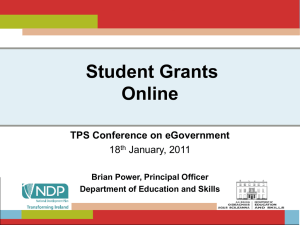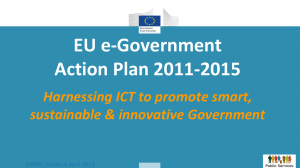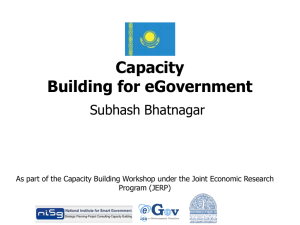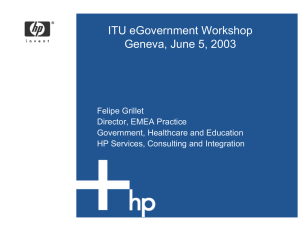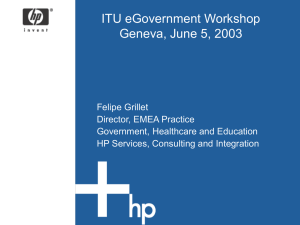A critical step in eGovernment evolution
advertisement
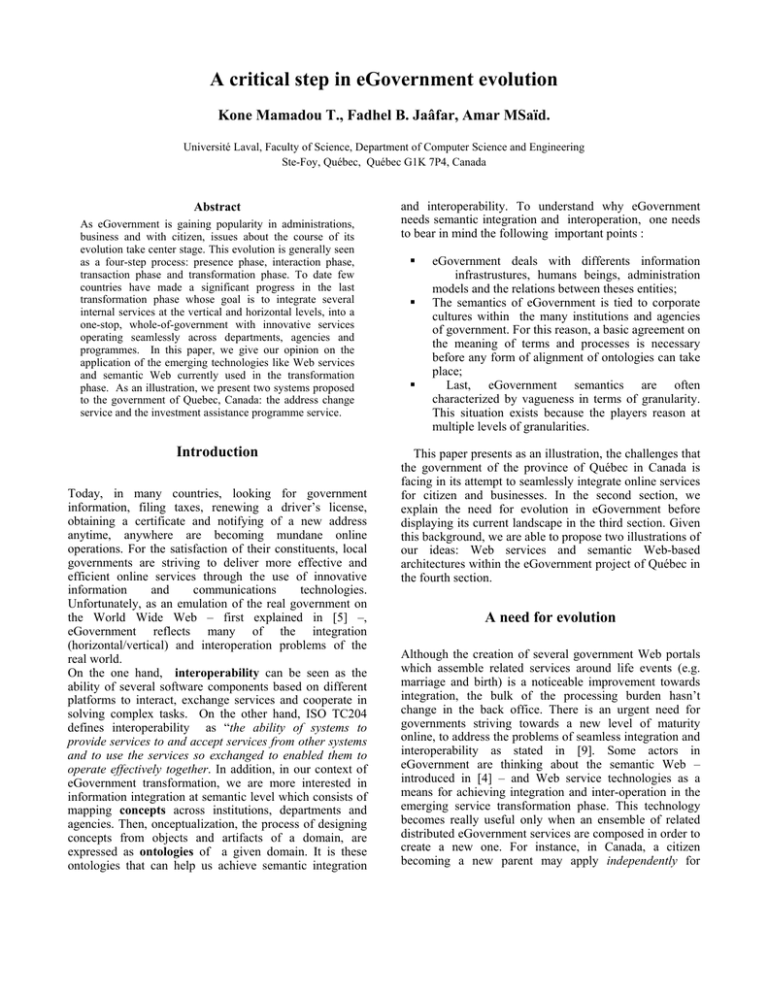
A critical step in eGovernment evolution Kone Mamadou T., Fadhel B. Jaâfar, Amar MSaïd. Université Laval, Faculty of Science, Department of Computer Science and Engineering Ste-Foy, Québec, Québec G1K 7P4, Canada Abstract As eGovernment is gaining popularity in administrations, business and with citizen, issues about the course of its evolution take center stage. This evolution is generally seen as a four-step process: presence phase, interaction phase, transaction phase and transformation phase. To date few countries have made a significant progress in the last transformation phase whose goal is to integrate several internal services at the vertical and horizontal levels, into a one-stop, whole-of-government with innovative services operating seamlessly across departments, agencies and programmes. In this paper, we give our opinion on the application of the emerging technologies like Web services and semantic Web currently used in the transformation phase. As an illustration, we present two systems proposed to the government of Quebec, Canada: the address change service and the investment assistance programme service. Introduction Today, in many countries, looking for government information, filing taxes, renewing a driver’s license, obtaining a certificate and notifying of a new address anytime, anywhere are becoming mundane online operations. For the satisfaction of their constituents, local governments are striving to deliver more effective and efficient online services through the use of innovative information and communications technologies. Unfortunately, as an emulation of the real government on the World Wide Web – first explained in [5] –, eGovernment reflects many of the integration (horizontal/vertical) and interoperation problems of the real world. On the one hand, interoperability can be seen as the ability of several software components based on different platforms to interact, exchange services and cooperate in solving complex tasks. On the other hand, ISO TC204 defines interoperability as “the ability of systems to provide services to and accept services from other systems and to use the services so exchanged to enabled them to operate effectively together. In addition, in our context of eGovernment transformation, we are more interested in information integration at semantic level which consists of mapping concepts across institutions, departments and agencies. Then, onceptualization, the process of designing concepts from objects and artifacts of a domain, are expressed as ontologies of a given domain. It is these ontologies that can help us achieve semantic integration and interoperability. To understand why eGovernment needs semantic integration and interoperation, one needs to bear in mind the following important points : eGovernment deals with differents information infrastrustures, humans beings, administration models and the relations between theses entities; The semantics of eGovernment is tied to corporate cultures within the many institutions and agencies of government. For this reason, a basic agreement on the meaning of terms and processes is necessary before any form of alignment of ontologies can take place; Last, eGovernment semantics are often characterized by vagueness in terms of granularity. This situation exists because the players reason at multiple levels of granularities. This paper presents as an illustration, the challenges that the government of the province of Québec in Canada is facing in its attempt to seamlessly integrate online services for citizen and businesses. In the second section, we explain the need for evolution in eGovernment before displaying its current landscape in the third section. Given this background, we are able to propose two illustrations of our ideas: Web services and semantic Web-based architectures within the eGovernment project of Québec in the fourth section. A need for evolution Although the creation of several government Web portals which assemble related services around life events (e.g. marriage and birth) is a noticeable improvement towards integration, the bulk of the processing burden hasn’t change in the back office. There is an urgent need for governments striving towards a new level of maturity online, to address the problems of seamless integration and interoperability as stated in [9]. Some actors in eGovernment are thinking about the semantic Web – introduced in [4] – and Web service technologies as a means for achieving integration and inter-operation in the emerging service transformation phase. This technology becomes really useful only when an ensemble of related distributed eGovernment services are composed in order to create a new one. For instance, in Canada, a citizen becoming a new parent may apply independently for several related online services like maternity leave, maternity benefits, declaration of birth, Canada child tax benefit (CCTB). When automatically combined into a single online service called “New-parent”, these online operations together suddenly take a new and more meaningful dimension. However, with different levels of public administration, issues of trust, security, confidentiality, and law are very likely to hinder service composition. We can’t help but ask ourselves if the context of government is suitable for the implementation of Web services technology. Before giving any opinion about this issue, we need to understand the current state of eGovernment. The current landscape of eGovernment eGovernment definition The most accepted picture of eGovernment is that of a provider of online services to citizen (G2C), businesses (G2B) and the administration (G2G) shown in figure 1 through the use of information and communications technologies. The real value of an eGovernment rests on the effectiveness of its programmes, the broad availability of its enhanced online services, the satisfaction of customers and the tangible savings in time, money and human resources. Figure 1. eGovernment standard components. eGovernment evolution eGovernment expansion and adoption by communities, citizen, businesses and public administrations in most countries is generally seen – like in [8] - as a four-step process: presence phase, interaction phase, transaction phase and transformation phase. The initial presence phase is implemented through the publication on the Web of static information on government operations and services. Starting with few services, the initiative expands to a broad range of services with basic capabilities like official publications, newsletters, e-mail contact and a FAQ section. Here, citizen, businesses and public administrations can easily search for or download familiar documents in addition to sending by e-mail inquiries to officials for particular matters. The interaction phase appears through the building of basic Web portals containing online forms, requests for proposal and opinion surveys on critical issues of interest to citizen and local businesses. In addition, some kind of cross-agency cooperation appears: government agencies start to reach out to one another through links in their official Web sites. The transaction phase offers online operations like a driver’s license renewal, a car registration, a request for a new passport and requires payment of fees in a complete and secure online setting. The proper implementation of these online transactions draws much from the technical aspects of similar transactions in eCommerce. An eGovernment architecture at this stage uses complete multi-tier architectures with authentication and digital signatures. The goal of the transformation phase is to integrate several internal services at the vertical and horizontal levels, into a one-stop, whole-of-government with innovative services operating seamlessly across departments, agencies and programmes. These services are therefore tailored to the needs of businesses, communities and citizens. As the emergence of eCommerce in the private sector is helping seamlessly integrate the delivery of services, providers in government are compelled to offer similar quality of service. According to a recent survey conducted by Accenture in [1], only the federal government of Canada has embarked on this stage. Taking another challenging step: transformation As countries like United States, Denmark, Australia, Finland, United Kingdom, Germany, Ireland and France are making remarkable progress in mature service delivery, questions arise about the appropriate technological platform for reaching the next level of service transformation. Until now, to design a platform for its service delivery, some government have quietly followed in the footsteps of the successful eCommerce where Web services technology – depicted in figure 2 – with its Web Services Description Language (WSDL), Simple Object Access Protocol (SOAP) and Uniform Description, Discovery and Integration (UDDI) protocols, appears to be the most popular. Figure 2. General Web services architecture. However, government providers not only have different goals in the design, organization, management and delivery of services than the private sector but face massive challenges under different constraints. According to [7], the most important of these challenges are safety, security, and integrity of online interactions with government; privacy and confidentiality of personal and business information within government; information management with respect to accuracy and relevance when merging data across departments and agencies. Although security technology for Web services addresses the safety, integrity and confidentiality concerns through cryptography, digital certificates and trusted third-party authorities, it is neither convenient nor stable enough to inspire trust. In addition, current research has shown that it is possible to automatically discover, select and compose Web services on a syntactic, semantic and pragmatic (location, QoS, policy) levels. However, to date, no Web service infrastructure has the capability of dealing with laws (e.g. the Privacy Act in Canada mentioned in [7]) related to the use and sharing of personal information where the explicit written consent of a subject is required. Last, but not least, the current composition schemes of Web services mention neither the ability to check the accuracy nor the relevance of data being merged. Therefore, the legitimate question here is: Are Web services a sound technological choice for implementing service transformation in eGovernment ? In Québec, Canada, there are some attempts to implement the semantic Web and Web services technologies in eGovernment infrastructure as eGovernment Web services. Since the creation of its new Ministry of government services few months ago, the government of Québec is soliciting the contribution of Laval University for the creation of an innovative architecture for its Web portals and a “Page of the Citizen” (Page du Citoyen) concept. To achieve these goals, we have embarked on a project which aims to introduce semantic Web and Web services technologies within the eGovernment infrastructure. Our first step was to demonstrate the effectiveness of our approach by selecting two online operations of particular interest to citizen and businesses: address change and assistance programmes for investors. information on citizen and businesses. Unfortunately, each of these organizations has its own concept of identification with rules and restrictions. The best example of this problem is the online address change Service of Quebec1 described in [3]. Here, the process of changing one’s address has been made easy by a single online form which serves six ministries and agencies simultaneously. Then, each destination still bears the burden of validating the address change. In the province of Québec, official records show that about 66 % of online address change requests through this system is rejected during validation. Therefore, with the aim of improving the current system and keeping alive users’ interest, we proposed the design and implementation of an eGovernment Web service platform described in figure 3. This platform supports functionalities and modules made of a Web service-based portal which plays the role of online middle man; the services request folder, an emulation of an electronic commerce shopping cart system; the service search module as a channel to available government services and an online address change service. We designed an appropriate ontology for government services with the Protégé ontology editor (see [15]) to support these operations. With the local information at ministries and agencies being processed as Web services, our platform is able to efficiently collect and process data then display query results to consumers. Here, as required by the law, there is no need for interaction between the players. Enterprise Gov. Agency Change request Internet Address Change Processing request Processing request Government ministry Web service The online address change challenge Government agency Address update Central Government Other elements of the local information system Data Other elements of the local information system Data Address update Web service Other elements of the local information system Data Web service The case of the government of Québec In Quebec, online services are organized according to the visitor’s profile (citizen or enterprise) and gathered according to specific topics such as finances, industry, business, education, employment and legal matters. To have access to online government services, one must visit a constellation of Web sites whose architectures does not allow integrated service provision like a one-time change of address in several administrations. In addition, the personal data protection law requires each government organization in Québec to build and manage its own secure online database with no possibility of sharing personal Citizen Figure 3. Structure of the online address change service. 1 SQCA in French The online investment assistance challenge The government of Québec conceived a Web portal and partially displayed in figure 4, as a source of information and resources for businessmen willing to invest in Québec. Figure 4. The Web portal for investors and startups. In particular, this portal helps users find investment assistance programmes of interest offered by different government entities. These programmes are incentives in the form of financial assistance, tax relief, subsidies and loan guaranties to encourage investment and job creation. In general, obtaining assistance is subject to the fulfilment of a number of conditions related to the profile of the investor and the nature of the investment project. The current Web portal for potential investors in Québec displayed in [10] uses traditional Web technologies. It takes the painful reading of the content of all displayed URLs in this portal to find a program suitable to one’s profile. When a potential investor is interested in several projects or a group of investors collaborate on a project, it becomes clear that the traditional procedure turns into an energy and time-consuming burden with no guarantee of success. To cope with this problem, we built a semantic Web infrastructure for investment assistance programmes described in [2] and based on four layers: a presentation, processing, working knowledge and persistent knowledge bases. The functionalities of this system described in figure 5 will help, on the one hand, provider organizations publish assistance programmes in an appropriate format and make them available to investors who can easily and quickly find suitable assistance. By suitable, we mean that the search profile fulfills all the eligibility conditions of the assistance programme. Here, the search profile is the combination of the profiles of the investor and the nature of his/her intended project. This search profile is described using terms selected from the set of ontologies drawn from the various programmes providers. At the core of this application are, on the one hand, the registration process of programmes done by an agency and on the other hand, the search for suitable programmes which match the profile of investors. The registration process: When a government agency decides to publish a new investment programme, it is registered as an OWL document in a public location on the Web or on the server of the organization itself. The process pictured in figure 5 below stands as follows: From a Web browser, the programme provider reaches out to the Web service consumer (SCW in the figure) and notifies of the URL of the program. The SCW queries the UDDI agency to find out the list of available SWPAI services. This list is then submitted to the provider who must select the location where his/her programme should be hosted. Following this procedure, the SCW service contacts the SWPAI service selected by the provider and calls the function enregistrerProgramme with the URL of the programme as a parameter. When the enregistrerProgramme is called, it performs three essential tasks: 1. It initiates a connection with the provider Web server and transfers the assistance programme by using the URL received as a parameter; 2. It stores temporarily this RDF/XML programme in two tables of a relational DB. The instances of these tables are then inserted in the knowledge base of the SWPAI service. 3. It updates the knowledge base by using The OWLJessKB tool described in [13]. This KB is then converted with the expert system development tool Jess. The semantic rules of the OWL reasoner are used by the inference engine to insert facts not explicitly written in the assistance programme but inferred from its ontology. Finally, the enriched KB is stored in the tables of the DB. Figure 5. The programme registration process. Matching programmes and profiles: This operation – depicted in figure 6 – helps compare the RDF graphs representing the profiles of the investor and the project with parts of graphs of the assistance program. The degree of pertinence is computed by considering the average of number of eligibility criteria fulfilled by the profiles of the investor and project and the total number of these criteria imposed by the assistance programme of interest in the SWPAI service. to say, instead of a yes/no answer, the user will be able to choose a level of eligibility between 1 (yes) and 0 (no). In addition, to make our system closer to the real life decision-making process in government assistance programs, we are looking forward to giving users the opportunity to change some features of the content of their application. Discussion on technologies for service transformation Figure 6. Finding a suitable investment programme. The domain vocabulary: All actors must share the same vocabulary to assure a coherent working of the system. For this purpose, a centralized ontology is maintained inside the portal by the SCW service consumer. The SCW service must poll the SWPAI services on regular basis with a call to the obtenirOntologie operation. This operation extracts from the knowledge base concepts and properties useful to the client SCW service. With all the results (concepts and properties) gathered from several SWPAI services in the system, the client SCW service builds a centralized ontology used simultaneously by the provider as a base vocabulary to describe the program and the client doing a search as a support for writing a request. The main services implementation: The SCW service has been implemented as a Java servlet deployed on the Tomcat application server. This way, the system can be used from a lightweight client connected to the Internet and enabled with a Web browser. In addition, in this servlet, all the Java API, UDDI and SOAP protocols implement the functionalities of a client Web service. We have used the IBM WSDK 5.0 tool kit to conceive and implement all the SWPAI service providers. This tool integrates a UDDI agency for the publication of SWPAI services. In our implementation, each SWPAI manages a knowledge base of a set of assistance programmes. This knowledge base described in the DAML ontological language can be easily transformed into a resource and an input for automatic reasoning tools (e.g. expert systems). In addition, the SWPAI implements an operation called obtenirOntologie for capturing the current domain knowledge to help users build their requests within the Web portal. The SWPAI service implements three basic operations: a new programme registration, querying the knowledge base and capturing the domain vocabulary. As the current implementation of this system provides no adaptation capability nor takes into account some subtleties in the fulfillment of eligibility conditions, we intend in the near future to include fuzzy sets techniques in the computing process of the degree of pertinence. That is After the presentation of the previous Web services-based eGovernment applications, we need to remember our original question: Are Web services a sound technological choice for implementing service transformation in eGovernment ? Since interoperability and integration are at the core of service transformation, understanding their real nature can be useful. Fishenden, Bell and Grose stated in [7] “Interoperability is concerned with more than just low-level technical issues. To be successful, interoperability programs need to address a range of issues that span technical, semantic, cultural and organizational interoperability as well as security, confidentiality, data protection, privacy and freedom of information obligations.” The effectiveness of Web services technology in transforming government should be measured in the way it accomodates all these aspects of interoperability. On the semantic side, the implementation of semantic Web services described in [6] together with the consistant representation of information within government is an interesting solution. For example, the discovery and semantic matching of all interpretations of the concept of address of a citizen or business can be done in the UDDI part of a semantic Web service architecture. On the cultural side however, Web services can hardly deal with “ways of doing things” and the personal issues of power over specific information. The most startling example is the lack of cooperation between some government agencies in charge of homeland security in United States before the September 11 tragedy. On the organizational side, Web services architectures have no way of semantically processing information from standards built in different administrative environments. The challenge of a single online address change that we introduced in a previous section is a typical example of conflict of standards because the representation of the address of an entity is clearly not the same for a number of government agencies. Therefore, our online address change service application will be of limited use when we think about vertical integration of government services on a large scale. Although Web services may bring much of the technical grounds necessary to achieve some aspects of interoperability and integration of information, it cleary is not sufficient to succeed complete service transformation. Conclusion In this article, we presented some obstacles in achieving service transformation in eGovernment with the implementation of the semantic Web and Web services technologies. As an illustration, we proposed the case of the government of Québec in Canada which is looking forward to apply these technologies in two key contexts: its online address change and online investment assistance programmes. Although these technologies may seem appealing, we realized during real world experiments that issues related to specific laws, security and confidentiality were very hard to deal with. References [1] Accenture, The Government Executive Series, eGovernment Leadership: High Performance, Maximum Value. URL http://www.accenture.com. April 2004. [2] Amar MSaid and Kone M.T. eGovernment assisted programmes in a Semantic Web. Proceedings of IADIS International Conference on e-Commerce 2004, Lisbon, Portugal. December 2004, pp. 131-142. [3] Ben Fadhel D. and Kone M.T. An eGovernment Web services platform on the semantic Web, Proceedings of EGOV05 – International Conference on E-Government 2005, Copenhagen, Denmark, August 2005. [4] Berners-Lee T. et al. The Semantic Web, Scientific American, 284(5), 2001, pp. 34-43. [5] Berners-Lee T. and Fischetti M. Weaving the Web: The Original Design and Ultimate Destiny of theWorld Wide Web by Its Inventor, Harper (San Francisco), 1999. [6] McIlraith S. A. et al. 2001. Semantic Web Services. IEEE Intelligent Systems, pp. 46-53. [7] Michelle d’Auray, Behind the Portal : Revealing the Challenges of Service Integration, ICA Information No. 74: General Issue, June 2001. [8] Gil-Garcia, J. Ramon and Ignacio J. Martinez-Moyano (2005): Exploring E-Government Evolution: The influence of Systems of Rules on Organizational Action. Natiional Center for Digital Government (NCDG ) Working Paper # 05-001. [9] Government of Canada, Connecting with Canadians: Pursuing Service Transformation. Final Report of the Government On-Line Advisory Panel. December 2003. http://www.gol-ged.gc.ca/pnl-grp/reports. [10] Government of Québec. Investing in Québec Web site, URL: http://www.entreprises.gouv.qc.ca/ wps/portal/. 2004. [11] Oreste Signore et al. E-government challenges and opportunities in Proceedings of the CMG Italy XIX annual conference, Florence, Italy, June 2005. URL http://www.w3c.it/papers/cmg2005Italy.pdf . [12] Sandia National Laboratories. 2004. Jess: the Java Expert System Shell, URL: http://herzberg.ca.sandia.gov/jess/. 2004. [13] Yuanbo Guo et al. An Evaluation of Knowledge Base Systems for Large OWL Datasets. Proceedings of the 3rd International Semantic Web Conference (ISWC2004), LNCS 3298, Hiroshima, Japan , Nov. 2004, pp. 274 -288. [14] Microsoft. Government Interoperability: Enabling the Delivery of E-Services. April 2005. URL http://www.microsoft.com/windowsserversystem/ interop/govt/govteservices.mspx . [15] Noy N. F. et al.. 2001. Creating Semantic Web Contents with Protégé-2000. IEEE Intelligent Systems 16(2):60-71.
